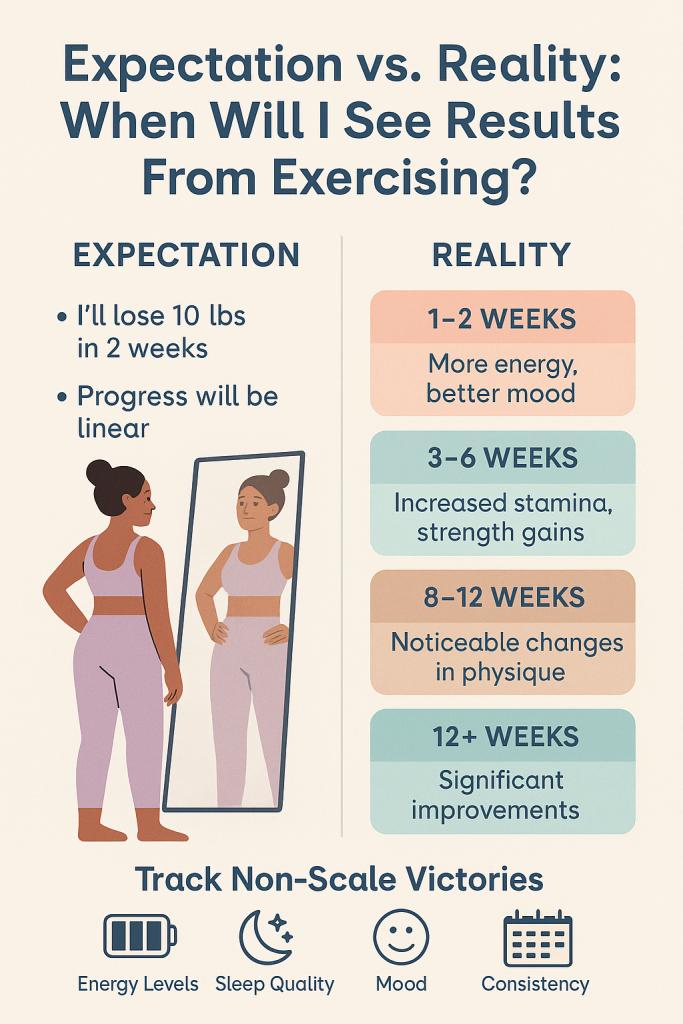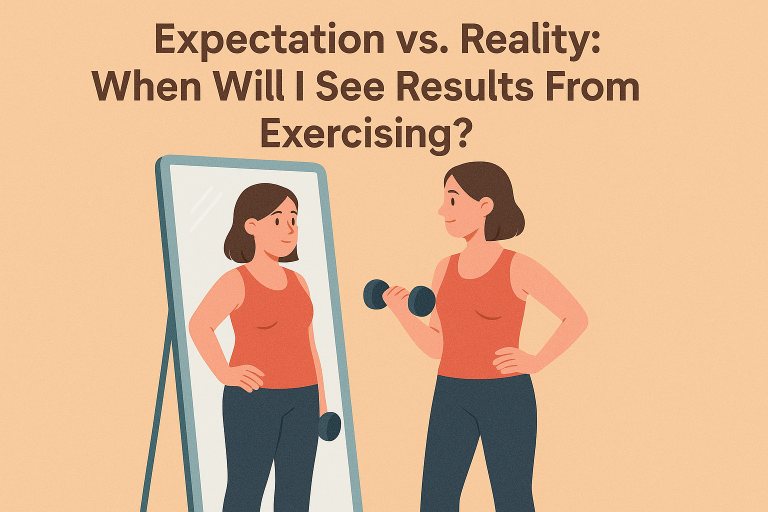Most people start working out with a big goal in mind—lose weight, get stronger, look more toned, or simply feel healthier. But after a week or two of effort, frustration often sets in: “Why don’t I see any results yet?”
The truth is: your body is already changing, even if you can’t see it. Some improvements show up internally long before the mirror catches up. Understanding realistic timelines—and tracking more than just appearance—can keep you motivated for the long haul.
In this guide, we’ll explore what happens to your body in the first weeks of exercise, when visible results typically appear, and how to measure success beyond the scale.

1. The First Wins: Internal Changes Come First
Research shows that your body begins adapting to regular exercise almost immediately—even within a single workout. But the earliest wins are often invisible:
- Better energy and mood (1–2 weeks): Exercise increases blood flow and stimulates neurotransmitters like dopamine and serotonin, which improve focus and reduce stress.
- Improved sleep quality (1–2 weeks): Even moderate activity, such as brisk walking, can lead to faster sleep onset and deeper sleep cycles.
- Stamina boost (3–4 weeks): Your cardiovascular system adapts quickly—your heart pumps more efficiently, and you may notice you don’t get as winded climbing stairs.
- Strength gains (3–4 weeks): Early improvements are mostly “neurological”—your brain gets better at recruiting muscle fibers, so you lift heavier or do more reps without actually adding new muscle tissue yet.
👉 Reality check: You are making progress, even if the mirror hasn’t caught up yet.
2. Visible Results: The Realistic Timeline
Everyone wants to know: When will I see results? The honest answer: it depends. Factors include genetics, starting fitness level, diet, sleep, and exercise type. But here are general evidence-based timelines:
- Weight loss/fat changes (8–12 weeks): With consistent exercise and dietary balance, many people notice clothes fitting differently within 2–3 months. According to the CDC, a safe and sustainable fat loss rate is 0.5–1 kg (1–2 lbs) per week.
- Muscle tone and definition (12–16 weeks): For beginners, noticeable muscle hypertrophy (growth) usually appears after about 8–12 weeks of resistance training.
- Cardio fitness (4–6 weeks): Endurance improvements show up faster—you may run longer or cycle further without fatigue in just a month.
- Flexibility and mobility (3–4 weeks): Regular stretching or yoga leads to noticeable range-of-motion gains relatively quickly.
👉 Reality check: You’ll probably feel results (energy, mood, stamina) before you see them. Visible transformation is a medium-term reward.
3. Why the Scale Isn’t Enough
The scale is the most common progress tool—but it’s also the most misleading. Here’s why:
- Muscle vs. fat: Early in training, you may gain lean muscle while losing fat, which keeps weight stable even though your body composition is improving.
- Water retention: Starting a new program often triggers temporary water retention as muscles adapt to micro-tears and glycogen storage.
- Fluctuations: Weight can swing 1–2 kg (2–5 lbs) daily based on hydration, sodium intake, or hormones.
👉 Better tracking methods:
- Waist/hip/thigh measurements every 4 weeks.
- Progress photos (same lighting, same clothes, monthly).
- Performance markers (push-ups, squat weight, running distance).
- Subjective markers (sleep, mood, energy).
4. Non-Scale Victories: The Hidden Results
Many benefits of exercise never show up in before-and-after pictures, yet they’re crucial for long-term motivation:
- Mental health: Regular exercise reduces symptoms of depression and anxiety as effectively as medication for some people.
- Stress resilience: Lower cortisol levels improve emotional stability and decision-making.
- Daily functionality: Carrying groceries feels easier, your posture improves, and your balance stabilizes.
- Disease prevention: Exercise lowers risk for type 2 diabetes, cardiovascular disease, and osteoporosis.
👉 Reality check: If your workouts make you sleep better, smile more, and stress less, that’s already a major success.
5. The Psychology of Expectations
Why do so many quit before results show?
- Instant-gratification culture: Social media promotes “12-week transformations,” but rarely shows the years of maintenance that follow.
- Comparison trap: Everyone’s genetics, metabolism, and starting point differ—comparing your progress to others can sabotage motivation.
- Unrealistic timelines: Expecting to “lose 10 pounds in a month” sets you up for failure when the safe range is half that.
👉 Mindset shift: Focus on consistency streaks (how many weeks you show up) instead of chasing instant physical change.
6. A Realistic Action Plan
Here’s a framework to stay motivated and track genuine progress:
Step 1: Define Two Metrics
- Visible metric: waist circumference, number of push-ups, 5K run time.
- Invisible metric: energy levels (1–10 scale), hours of sleep, weekly mood rating.
Step 2: Track Monthly, Not Daily
- Measure every 4 weeks, not every morning. This avoids frustration from normal fluctuations.
Step 3: Celebrate Streaks
- Reward yourself for consistency (e.g., 4 weeks without missing a workout) with non-food rewards: new gear, a massage, or a fun outing.
Step 4: Accept Plateaus
- Progress slows after the first few months—adjust training (intensity, variety, rest) instead of quitting.
7. Expectation vs. Reality Snapshot
| Expectation | Reality |
|---|---|
| “I’ll lose 10 lbs in 2 weeks.” | Sustainable fat loss is 1–2 lbs per week. |
| “I’ll see abs in a month.” | Visible abs depend on body fat % and usually take months, not weeks. |
| “I’ll feel stronger after 3 months.” | Strength improvements start within 3–4 weeks (nervous system adaptation). |
| “If the scale doesn’t move, I’m failing.” | Body recomposition can mean fat loss + muscle gain, with no net weight change. |
| “Progress is linear.” | Progress comes in waves—plateaus and spurts are normal. |
8. Conclusion: Trust the Process
The gap between expectation and reality can make or break your fitness journey. If you expect overnight transformation, you’ll likely quit. If you understand the body’s natural timelines, you’ll see that every week of consistency is moving you forward.
- Weeks 1–2: Feel more energized, sleep better, stress less.
- Weeks 3–6: Notice stamina, strength, and flexibility gains.
- Weeks 8–12: Clothes fit differently; endurance feels effortless.
- Weeks 12–16+: Visible definition, measurable fat loss, and long-term habits set in.
The takeaway: Don’t chase instant results. Track non-scale wins, celebrate consistency, and let time do the heavy lifting.
As a bonus, here’s a 12-week progress tracker that you can download and use to keep up with your new habbits.




